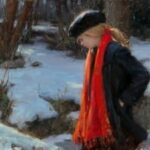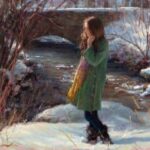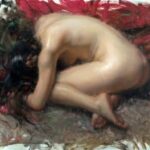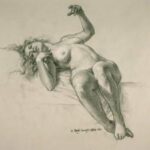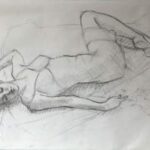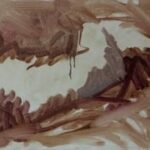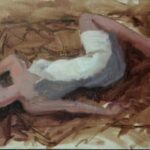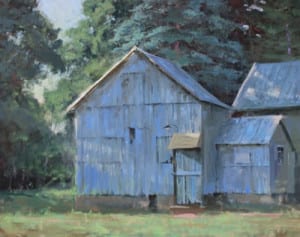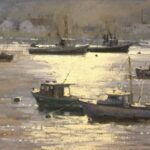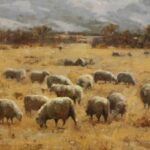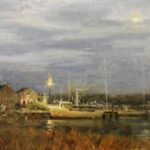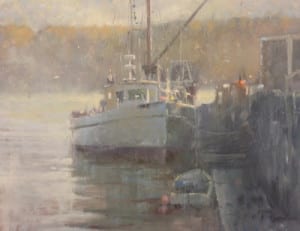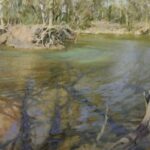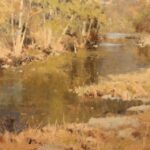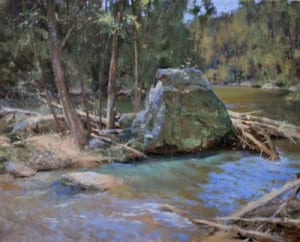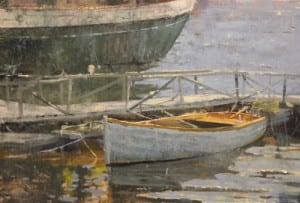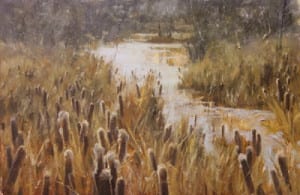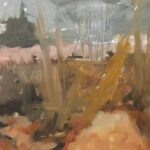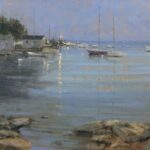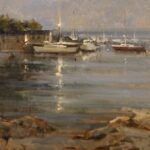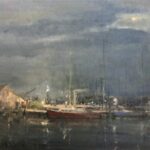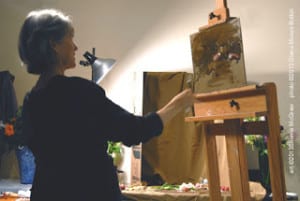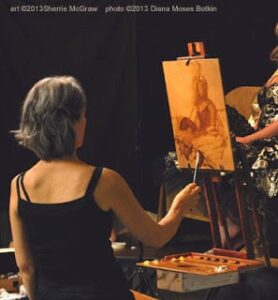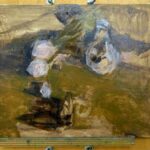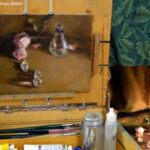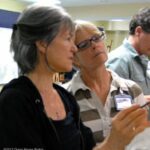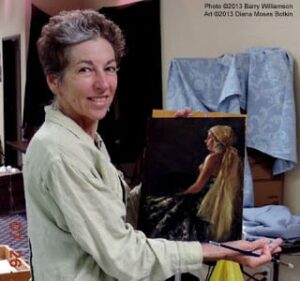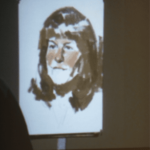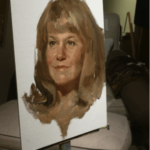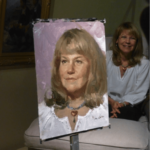“Being an artist and painting the human figure is what compels me. It wakes me up at night, it’s what I love and I drive myself to do it very well. Art is my lifelong obsession, pleasure, and torment.”
One thing I have learned about Bryce Liston during this interview process…he’s a very professional, dedicated, and responsible artist. But why should I be surprised? Except for a short time at the University of Utah, he has directed his own educational path. It’s been a path of very focused, hard, persistent work, and he believes that the lack of formal art education actually helped him discover his “voice”.
Freed from the influence of the so-called “sophisticated voices” of college art departments, that tend to scorn illustration, or anything representational for that matter, Liston fell in love with the works of Pyle, Wyeth, Rockwell, and others. These great illustrators of the past proved to be instructive and immensely inspirational.
Liston knows what it takes to succeed in this business, but he also knows it takes more than just hard work. In a recent blog posting, he closed with a quote from Edgar Payne, “Great patience is called for on the hard path that I have entered on.”
I’m pleased to bring you this wonderfully informative interview with Bryce Cameron Liston.
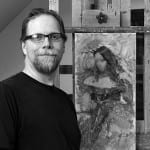
Why are you a figure painter?
Great figurative art is an enduring depiction of the human experience. The human form completely inspires me. People are beautiful, mysterious, ever changing and completely individual.
I grew up looking at the wonderful art of the great illustrators, like Howard Pyle, N.C. Wyeth, Frank Frazetta and Norman Rockwell. In school I spent hundreds of hours pouring over the images created by those great artists. I guess that’s not such a great thing to be doing in math class…maybe that’s why I never “got” math. I think back to those wonderful and powerful Frazetta paintings, and how he painted the human form. His characters were alive, dramatic and VERY sexy– it really stimulated my imagination. I’ve been focusing on the human form ever since.
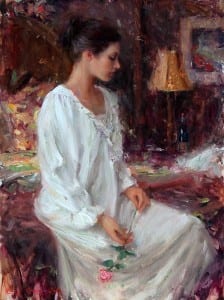
What training did you receive in order to pursue your career?
I have had little to no official training. I’ve gathered information and training in my own manner. Growing up in a rural area of Utah in the 70’s and 80’s, resources and financial backing were very limited for me. So with that facing me, the local university seemed to be my best option. Boy was I disappointed! It only took a little over a year to decide it was not the right fit for me. I wanted to learn about the craft of art. I wanted to learn to actually produce art, not just discuss it. I wish I could have found some solid training back then, but can you imagine finding about far flung art schools without any internet and very little money? My only connection to the art world at that time was an institution that had no patience for traditional art. And then, I was fortunate enough to find a world class sculptor living in my area that needed some help in his foundry. So I spent 15 years working for sculptor Edward J. Fraughton. Ed was very liberal with his advice in the arts. Many times it felt more like I was in a school than a foundry. I learned a lot about anatomy, gesture, line and composition, not to mention being on the receiving end of some great lessons in art history. It’s funny, I learned about painting from a sculptor- I don’t think that’s something that happens every day. Obviously for painting there were certain gaps, such as color, value and edge. Since my time in the foundry I have worked very diligently to increase my skill up in those areas.
So, you really don’t think you received sufficient training to be an artist?
No, not even close. I continue to learn every year, every week, every painting. It’s what drives me. Degas said it best I think…on his death bed it is reported he said, “Damn and just when I was starting to get it.”
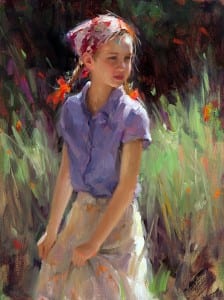
Knowledge and procedure
Does one need to have a thorough knowledge of anatomy to be a good figure painter?
I live by and teach this quote by Robert Beverly Hale: “First you draw what you see. Next, you draw what you know, and only then, will know what it is that you see”. It’s a brilliant statement; it’s stated so simply, but behind those words lie a lifetime of study for anyone. So yes, anatomy is very, important. In fact, coming at art partially through sculpture, anatomy is paramount. The sculptor works with form first (anatomy), and he knows his form is correct by the way the light falls on it. The painter approaches it in almost the opposite direction (albeit a complementary one). And that is, he paints the light and when he gets the effects of the light accurate, the form will read correctly.
How much of your work is done from life?
I have always worked from life, be it drawing, painting or sculpture. I continue to work from life each week as many times as my schedule will permit. But I must admit that I’m not the fastest painter. So in order to obtain the finish needed in much of my work I also need to use photographic reference. Many of my paintings are a collaboration of both life work and photo reference. My studio is also my place away from the world, it’s my refuge. I would find it difficult if I had to share all this time with a model.
What’s the key thing you’re trying to capture when painting the figure?
I guess it depends on what my particular subject is and how I’m feeling at the time. Many times it’s just the desire to turn the form. That is, making something look three-dimensional on a two-dimensional surface. It’s that sculptor in me I guess. I love the lines of the figure, especially the female figure, and trying to capture the subtle lines and gestures in a figure can be extremely challenging.
Is the popularity of the female form in art throughout history a result of artist’s being predominately male…or is there another reason?
I certainly think that aspect can’t be ignored, but it is certainly much more than that. I enjoy working with the simple beauty and the elegant flowing lines of the female form. There is certainly a sensuality and grace to the form; it’s beautiful and lovely in so many, never ending ways. It’s interesting that most of my female artist friends agree that they also enjoy working primarily with the female figure.
Working with the model
When setting up the model, what is the main thing you’re after?
Line and gesture are always at the forefront of my thoughts. Shapes come in next along with the lighting.
How do you typically select and work with your models and how are they compensated?
Beyond using my family members, the selection and use of models, quite often is a hit and miss game. I like to work with someone outside of my studio first, that is, in an open group of artists. That way I get to know the person first before inviting them into my personal space. Personality is so very important; I have to enjoy working around the person. And as far as compensation, it’s typically an hourly rate.
It’s one thing to capture a likeness, it’s another to capture one’s inner character, how is that accomplished?
I can’t tell you how many times I’ve been working on a piece and felt like it looks very much like the model, but I can see it’s technically a bit off, so I proceed to “fix it”. In the end I know that it’s technically correct, but now it no longer looks exactly like the model. I believe the painter is painting the person’s essence, their spirit if you will. I don’t know exactly how it happens; it just kind of sneaks in there when you’re not looking. That is one reason an artist’s portrait far exceeds a photograph.
Describe your working procedure.
I seem to approach nearly every painting a bit differently. I keep thinking maybe someday I’ll do it the same way each time. But the more I learn about myself the more I realize this is the way I’m wired. I guess it’s a way of keeping things fresh. Sometimes I start with a drawing of the subject or figure. I like having a drawing to refer back to in case the painting gets out of whack. But many times I just start drawing on the linen.
Beyond all of that, I first look for the overall design, flow and placement of the subject matter. A strong design is the foundation of any great painting. After I feel I have a good start with the design I start looking at the light. I ask myself what temperature is it? What direction is it coming from and what is the intensity? The light unifies all the elements in the painting. It gives the painting its mood.
The Process
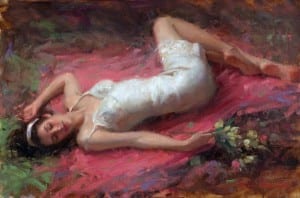
How thorough is your initial drawing?
It depends on how complex the painting is. On a simple painting I will only indicate the drawing with simple geometric shapes. If I’m working out a more complex painting I can spend days working on the drawings.
What colors are most often found on your palette?
Titanium white, flake white, cad yellow lt, cad orange, cad red lt, perylene red, quinacridone violet (mostly I mix those two together to make a very good permanent alizarin crimson), ultramarine blue, viridian, turquoise blue, yellow ochre, raw umber, ivory black. This is a general overall list of colors I typically use; I don’t always have all of these colors out. Many times I will limit my palette or simplify it depending on what I’m painting.
Perseverance and painting what you love
How does one find their individuality as an artist?
I think in this day and age that can be a bit difficult. I mean, the whole planet is at our fingertips instantly. We can look at nearly every style and approach by nearly any artist anywhere in the world from any time period. It’s easy to maybe lose yourself in there somewhere. It’s important to ask yourself, what excites you? What type of scenes enliven and motivate you?
Do you experience dry spells, where everything seems to be a struggle? If so, why do you think that is?
Yes, it actually happens quite often for me. I have determined it can be caused by several different factors. The first is plain and simply overworking. I don’t mean overworking an individual painting (that happens too, but it’s a by product) I mean too many hours and too many deadlines back to back. The artist’s mind needs time away, time to think, rejuvenate and just experiment. I guess the saying fits “all work and no play makes Jack a dull boy”.
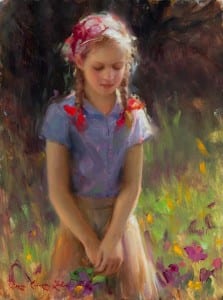
Landscape has been the most salable subject for years, do you see that changing?
I don’t see that changing. In fact with the huge popularity of plein-air painting right now I see landscapes becoming even more popular. I think it takes a gutsier collector to buy figurative art, and of course people who purchase nudes, are even more so. Figurative art tends to make a statement; it’s more personal. Landscapes are simply more accepted, more passive. I have been told by some people they don’t collect paintings of people because they don’t want someone they don’t know in their home. But really, when most of us think of great artists of the past…and the greatest of all work…what and who comes to mind first? Velasquez, Rembrandt, Vermeer, Titian, Michelangelo, Courbet, Sargent, Sorolla, Repin, Fechin..etc. are all at the top of the list. Great figurative art is an enduring depiction of the human experience.
Influences and wise advice
What advice would you have for a young artist/painter?
DRAW, DRAW, DRAW! Paint and draw all the time. Do it now! Do not wait. Do not think you have a lifetime because it takes your whole life to figure it out. It’s about mileage and pushing yourself to grow and learn. Learn while you’re young, you learn more efficiently. So do it now and don’t ever let anyone tell you that you can’t be an artist! Your doubt and your fear are truly your greatest enemies.
What advice would you have for a first-time collector?
Collect from your heart. Collect art that speaks to you; you’ll know it when it does. You’ll feel that little twinge in your gut when you see that painting across the gallery, and it makes your pulse quicken and calls you over for a closer look. Those are the paintings to add to your collection.
If you could spend the day with any three artists, past or present, who would, they be?
This can be a daunting question. When choosing an artist from the past I always wonder if you should take their personality into the equation. I mean, I would love to spend the day with Sargent, Zorn or even Sorolla, but I believe they wouldn’t have much time or patience with me or anyone else asking a bunch of questions. They seemed to be men with large egos, larger than life and in certain circumstances perhaps not the nicest people. But that’s a big part of what made them great artists. I do know a little bit about Norman Rockwell and I’m pretty sure a day spent with him would be very enjoyable, smoking a pipe or two and learning a lot to boot. As far as artists alive today, I would love to have some time with Zhang Wen Xin. He’s a Chinese artist that lived in the U.S. from 1987 to 2005. When he was in the U.S he would make his way up to Salt Lake City from Taos to teach workshops in the summer. I did manage to take part in some of his workshops, many, many years ago. But I look back now and realize that nearly everything I saw and that he said went way over my head. If I had the same chance now, I think I might be able to grasp a little of his genius.
You asked for three artists, so I will throw in John William Waterhouse. He is one of my all time favorites and I believe he was a humble and sincere man. I would love to know more about his process and thinking behind his paintings…but really, just the chance to watch him work…priceless!

If you were stranded on an island, which three books would you want with you?
Well first off I would want the U.S. military survival guide. Because I’m pretty sure I wouldn’t have the ability to make coconut and banana cream pies like Marianne. Beyond that I guess just about anything by John Steinbeck. Or perhaps the Lord of the Rings trilogy would be nice. On the other hand perhaps that would be a good time to try to take in War and Peace or Moby Dick.
Who has had the greatest influence on your career, and why?
Again, I would credit those illustrators I mentioned above. But perhaps the reason I was so interested in those artists to begin with was because I grew up around art. My Mother was an artist and art was always prevalent in the house. I always had the smell of turpentine, oil paint and varnish in my house and oil paints in the freezer—I mean, didn’t everyone?;-). Many times I would go out with her and her friends while they painted plein air. Although at the time it bored me to tears, I think it must have planted a seed in my subconscious. Looking back I remember how bored I was, you know kids like to be around other kids, and these were…well…OLD people! I realize now (with a smile) that many of them were probably younger than I am now.
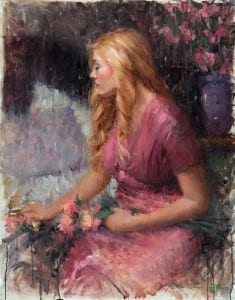
What does it take to become a successful artist?
I think that‘s very individualistic. We’ve all had a completely different set of experiences and input. Some start early in life, some later. Some of us have families to support. Some artists have had great teachers or schools, and fortunately we all want something different out of art. But beyond all of that, it takes persistence. I think when you’re starting out it really helps to have support; support of family, friends, teachers and the current education system. Try to find your own voice, but don’t worry too much about that in the beginning. Just get your skills up.
How do you know when a painting is finished?
Probably about three or four hours before I think it is.
If you could begin all over again, knowing what you know now, what would you do differently in developing your career?
Wow, that’s a loaded question. If I dwell on it too much I start down that uncomfortable road of resentment. But I guess the first thing is, I would NOT listen to anyone who told me I could not be and artist, ranging from my family to the school system. I would have found a way to attend an art school or move to an area that had a great teacher, and I would have worked a LOT harder when I was young even if I had no money.
How many hours do you typically paint per day?
It can range from 2 to 14. But I prefer to paint about 6 hours per day. I find much beyond that I get a diminished return. But deadlines and pressure from galleries can make for some very long days. People who think it’s easy to be an artist should try it for themselves. Forcing the creative spirit to be there when you need it can be very challenging
Many thanks Bryce for submitting to this interview, and thank you for contributing such beautiful work to this world.
